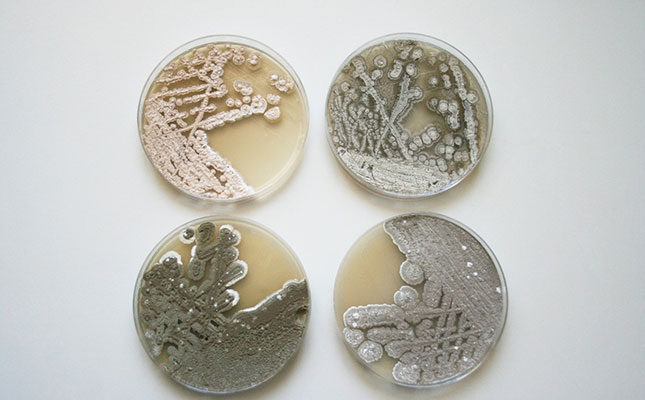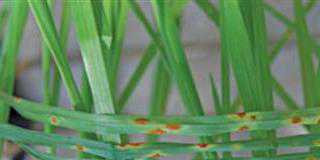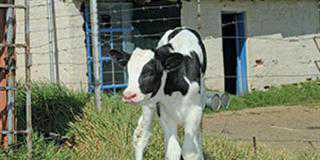
Photo: Dr WJ Botha
With the expected increase in world population in the coming decades, crop yield per hectare and a reduction in the use of chemicals in agriculture will both be of paramount importance.
Actinobacteria or ‘ray bacteria’ are Gram-positive bacteria that comprise a significant percentage of soil microbial populations, the soil food web and the root microbiome (the community of micro-organisms, such as fungi, bacteria and viruses that exists in a particular environment and colonises the root systems).
They resemble fungi in their morphology, forming branching, thread-like filaments, asexual spores in chains and densely packed filaments or mycelia.
Actinobacteria usually grow in warm and damp soil. After a long period of dry weather, their activities slow down. When the soil is moistened, actinobacterial spores ‘awaken’ and release a by-product called geosmin, which causes the characteristic, fresh, earthy smell.
Some species form mutualistic relationships with plants, promoting root growth and protection against pathogens. (Mutualism is an interaction between different species that results in beneficial outcomes, promoting reproduction and/or survival of the interacting populations.)
Streptomyces
Streptomyces species are the most plentiful and important actinobacteria, and comprise between 10% and 50% of soil microflora communities. Most are free-living and occur in both natural and agricultural environments, where they colonise plants’ root zones and different morphological parts of the roots. Around 679 species of Streptomyces have been described, and populations are adapted to a wide range of ecosystems.
Streptomyces spores occur mostly in the surface layer of soil and gradually decrease in number with soil depth, with estimated values ranging from 10 000 to 10 million spores per gram of soil. They are susceptible to acidity/low pH (optimal pH range 6,5–8,0) and waterlogged soil conditions.
Plant growth-promotion qualities
Streptomyces species produce numerous bioactive compounds, such as antibiotics, phytohormones and cell wall-degrading enzymes. In addition, they function as biocontrol agents or antagonists of soilborne pathogens and plant growth-promoting activities through the production of phytohormones and secondary metabolites.
They also function as bioremediation agents; that is, they help to reverse or halt the damage caused to contaminated soil and water by targeting the contaminants. Specifically, they degrade pesticides, destroy soilborne pathogens and remove heavy metals.
As a biofertiliser in the root zone, Streptomyces act through the formation and release of numerous bioactive compounds and enzymes that decompose complex organic substrates and convert them into soluble compounds for root absorption and root growth.
In nutrient- deficient soils, some species of Streptomyces fix atmospheric nitrogen and convert it to ammonia and nitrate. In addition, complex forms of phosphate, potassium and zinc are converted to a soluble format for root absorption.
Streptomyces species also produce iron-binding siderophores in the soil. These are molecules with a high affinity for iron that are formed under iron-limiting conditions to capture scarce iron resources from the environment and convert them to soluble forms for root absorption. Iron is essential for chlorophyll production in leaves and efficient photosynthesis.
In addition, the thread-like filaments coat and colonise root cells as epiphytes (found on
the surface of roots), and endophytes (found inside the roots). The interaction between roots colonised by actinobacteria and the metabolism of phytohormones and disease suppression activates the plant’s natural defence barriers to infection.
Actinobacteria act as modulators of plant disease and symbiosis through a complex interaction between the colonised root microbiome and the plant genome. (Symbiosis is any relationship or interaction between two dissimilar organisms; the type of symbiosis depends on whether either or both organisms benefit from the relationship.)
Climate change mitigation
Actinobacteria also have the potential to mitigate the negative effects of climate change and accelerate the recycling and retention of atmospheric carbon. Soil carbon sequestration or capturing regulates the uptake of carbon-containing substances from the atmosphere and soil organic matter, as well as its storage in soil and microbial carbon pools.
Soil microbial communities (SMCs) and actinobacteria play a major role in carbon cycling. The composition of SMCs is essential to the preservation of soil ecosystem processes. The activity of SMCs controls the throughput and provision of nutrients and the pace of decomposition of soil organic matter.
Colonisation of roots by species of Streptomyces and the production of bioactive compounds may alleviate abiotic stress caused by drought, salinisation, acidification, nutrient deficiency, metal toxicity, heatwaves and waterlogging. Therefore, considering their plant growth-promoting activity, Streptomyces species represent an excellent alternative for improving nutrient availability to crops and promoting innovation and sustainability in agricultural systems.
In conclusion, there is huge potential for the commercial application of actinobacteria in nurseries, hydroponics systems and agricultural soils. Actinobacteria may therefore be considered valuable friends of farmers, plants and the soil food web. (This comprises microbes and soil microfauna that play an important role in soil productivity by controlling biogeochemical processes such as nutrient-recycling, and retention of carbon and nitrogen in soils.)
Bio-inoculants and shelf life
Several commercial bio-inoculants of Streptomyces are marketed for agricultural applications. Commercial microbial bio-inoculants are available in four types: powder, liquid suspension, granules and slurry. The physical formulation of Streptomyces-based products also indicates whether these microbials should be inoculated in agricultural systems before or during cropping.
The efficacy of bio-inoculants is affected by abiotic factors, such as soil type, nutrient levels, moisture content, pH, trace metals, climate, and agricultural practices. Bio-inoculants may be applied as a soil drench or a seed coating.
Above-soil plant vegetative parts are inoculated by spraying a suspension of the bio-inoculant on aerial parts of the plant or submersing the roots of seedlings into a spore suspension before transplanting.
The shelf life of active Streptomyces spores in water-soluble powders depends on the qualities of the carrier or medium. Dry powder-based inoculants can attain a shelf life of one to two years under storeroom conditions. Commercial inoculants are required to have a prolonged shelf life and retain their vital biological characteristics. In the case of
Streptomyces bio-inoculants, these are to:
- Support the growth of bio-active spores of the micro-organism;
- Sustain the required number of viable microbial cells in sound physiological condition for an extended period;
- Dispense abundant spores at the time of inoculation to attain a plant response; and
- Prepare inoculants consisting of a blend of different barcoded and typed strains.
Most current agricultural systems depend on the use of chemical fertilisers and pesticides. However, recurring use leads to pollution of the soil, air, and groundwater. Beneficial agricultural micro-organisms applied as microbial inoculants are an important factor in the quest for sustainable agriculture and the production of healthy food while preserving natural resources.
The use of naturally occurring beneficial micro-organisms in soil ecosystems improves the soil’s physical-chemical properties, productivity and strength, and supports microbial development in combination with promoting plant growth and crop yield.
Curation of fungi
At present, approximately 150 strains of Streptomyces are maintained in the National Collection of Fungi at the Biosystematics Division of the Agricultural Research Council’s Plant Health and Protection Research Institute.
Strains of Streptomyces have been isolated from several hosts, such as macadamia, blueberry, avocado, citrus and maize soils. More strains will be characterised and curated in future and deposited in the collection to serve as a national repository and reference biobank of actinobacteria.
Email Dr WJ Botha at [email protected].











